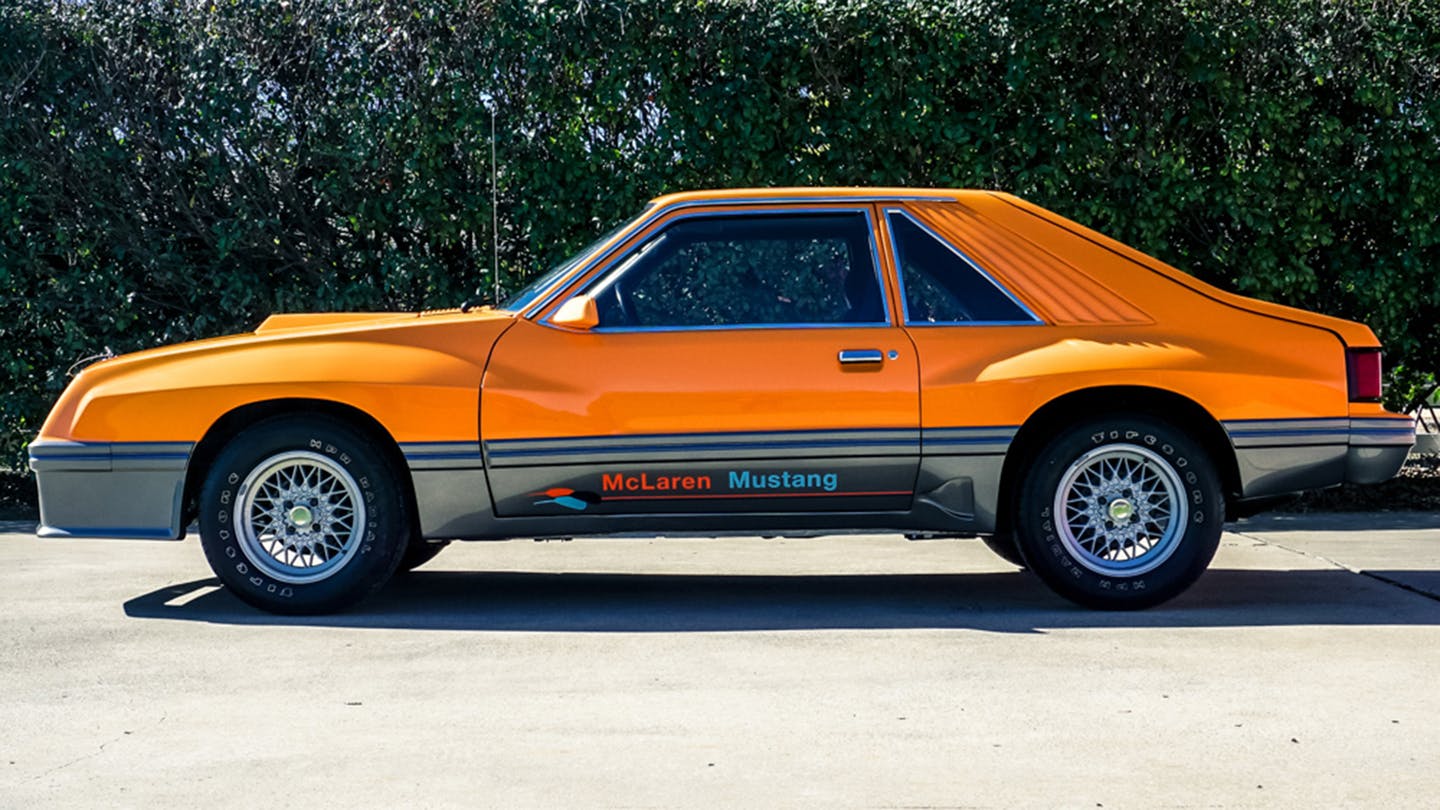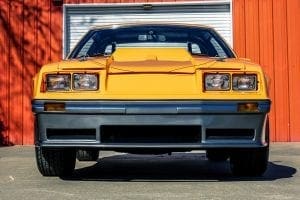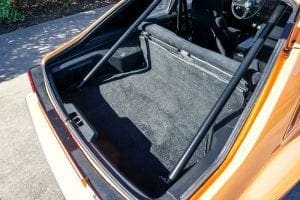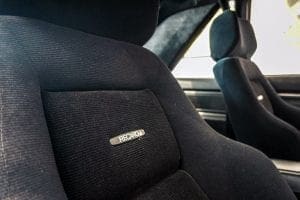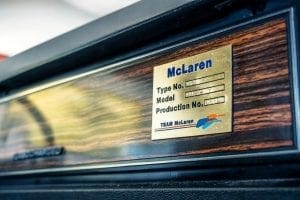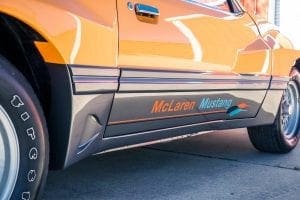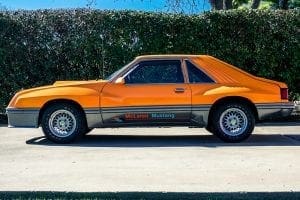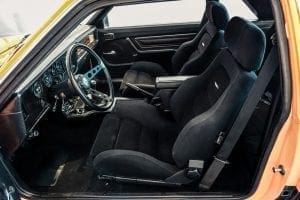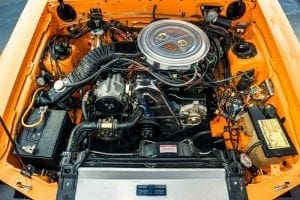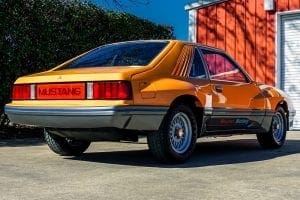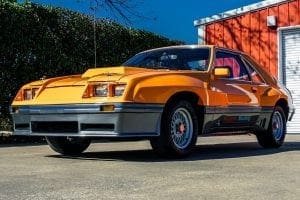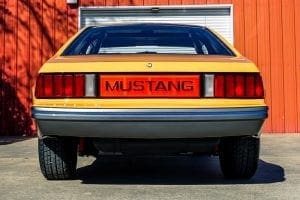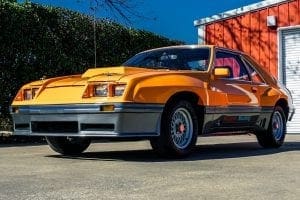1980 SVP M81 McLaren Mustang
Wild-Looking Fox Body Prototype
Probably the most interesting event in the 1980 model year was the development of the M81 McLaren Mustang. Whether it is really a 1980 or 1981 may be up to argument. The fact, is however that the concept that started in the spring of 1980, led to the formation of Special Vehicle Operations (SVO) who was responsible for designing and producing the car, and set up specifically to create limited production performance vehicles to enhance Ford’s performance image through motorsports.
The result was a wild looking car with wide IMSA flares at all sides,a factory roll bar,BBS alloy wheels and Recaro seats. The engine was a modified version of the 2.3 liter turbocharged motor. Increased boost and standard hot rod technology,bumped the power up to 175 hp. Although some 250 of these cars were planned, only a few were ever made. We dive into some of the story behind this truly awesome Mustang special.
The Background
The time is the late 1970s and OPEC had changed the rules. Better fuel economy was in and big-block V8s were out. The end result was engines and cars got smaller and more efficient and the trade off was performance (in most cases). The realities of a energy crisis and the emergence of more strict emission standards as well as lackluster innovation by muscle car makers meant the world had changed and they had to also.
The future was going to be smaller and nimble with an emphasis on handling. For Ford, it means getting rid of the 5.0L V8 in the Mustang in 1980 as a first step. Ford tried to save V8-face with a destroked 4.2L V8 but it truly sucked (try saying V8 with only 118 hp with a straight face). That meant that performance engine for the 1980 Mustang range was the 2.3L four-cylinder turbo. In today’s world we know that smaller displacement engines coupled with forced induction can be mighty and Ford was thinking the exact same thing back in 1980.
Ford was trying to move past the Mustang II and get people excited about its 2.3-liter four-cylinder turbo engine that would serve as a mid range option below the V8s in the third-gen model. Ford wanted to bring more attention to the potential of the 2.3L Turbo and needed a plan.
Partnering with McLaren
The company decided to partner with McLaren in 1980 – at that point still a racing and powertrain engineering shop – to create a joint Mustang prototype showcasing a hand-built McLaren engine and the breadth of Ford’s off-the-shelf motorsports parts inventory. The concept was quickly greenlit and scheduled for a limited production run of 249 cars. However, only 10 were produced before slow sales and a $25,000 price tag (around $75,000 today) scuttled the project, and of those just seven were swathed in aptly-named Bittersweet Orange paint.
Besides, changes weren’t just confined to the engine. According to Hagerty, body modifications like the grille-less front, bulging hood, wide steel fender flares, functional brake ducts, and BBS wheels were the work of Creative Car Craft. Below the tweaked sheet metal, an adjustable Koni suspension with heavy-duty sway bars and high-rate springs, upgraded brakes, Firestone HPR tires, and a bolt-in roll bar ensured the McLaren Mustang handled like no other Ford. And inside, touches like Recaro seats, a Racemark steering wheel, Stewart-Warner instrument gauges, and optional air conditioning matched the modus operandi.
The Engine & Performance
McLaren blueprinted, polished, de-burred and reassembled an essentially stock variation of the 2.3L Turbo for the M81. At 5psi of boost, horsepower was comparable to a stock 2.3L turbo, but the extra attention from McLaren to the rolling assembly allowed the M81 to have a much higher and variable boost. The boost control was inside the car and adjustable from 5-11psi (very cool).
Rated output was 175 horsepower (at 10 psi), a big jump over the standard engines 132 horsepower. Torque was 145 lbs/ft at just 3,000 rpm at the lowest boost setting. The 4-speed manual in the prototype will be replaced by a new 5-speed in the production models.
Suspension was also upgraded. The M81 had fully adjustable Koni shocks and struts with higher-rate springs. Sway bars borrowed from the police packaged Fairmont with tungsten bushings were also used. Brakes for the production based M81 were 10.6” front rotors with semi-metallic brake pads, larger calipers borrowed from the V8 Mustang and 9” drums in the rear. For the IMSA GTO beefier Hurst/Airheart disc brakes front and rear.
Performance as expected was awesome compared to the standard model even if by today’s standards it sounds weak. The M81 Mustang went from 0 – 60 mph in 9.76 seconds and completed the quarter mile in 17.37 seconds at a speed of 79.20 mph. This was a Motor Trend test with boost control was set at 7psi so there was more performance left in the tank for sure.
The Design
There is no mistaking an M81 from the outside. This Mustang received a lot of attention in the wind tunnel early during design. The fully functional extracting hood and chin spoiler plant the front of the Mustang with confidence at speed. Active front and rear brake ducts keep component temperatures down. And enormous steel fender flares stretch out to cover a wider than stock stance and 255/55 rubber.
A Rare Mustang
The requirements from Ford (great handling and performance as well as use of off the shelf parts) were easily met so the green light was given for a limited edition production run of 249 vehicles. Unfortunately it never happened. This hand-built Mustang was a whopping $25,000 (in 1980). In total only 11 cars were ever made (7 created in Bittersweet Orange, 1 Black, 1 White and 2 Enduros) making this one of the rarest Mustangs ever built.
Basic Specs
- Engine: 2.3 litre turbocharged 4 cylinder engine
- Power: 175 horsepower
- Torque: 155 lb/ft @ 3,000 RPM
- Transmission: 4 speed manual transmission
- Weight: 1171 kg
- Top Speed: 95 mph
- 0-60 mph: 9.76 seconds
- 1/4 mile: 17.37 seconds @ 79.20 mph
Pictures
The pictures are courtesy of the auction house selling the car, Barrett Jackson. The original listing can be found here for the car shown on this page. Original Listing.


